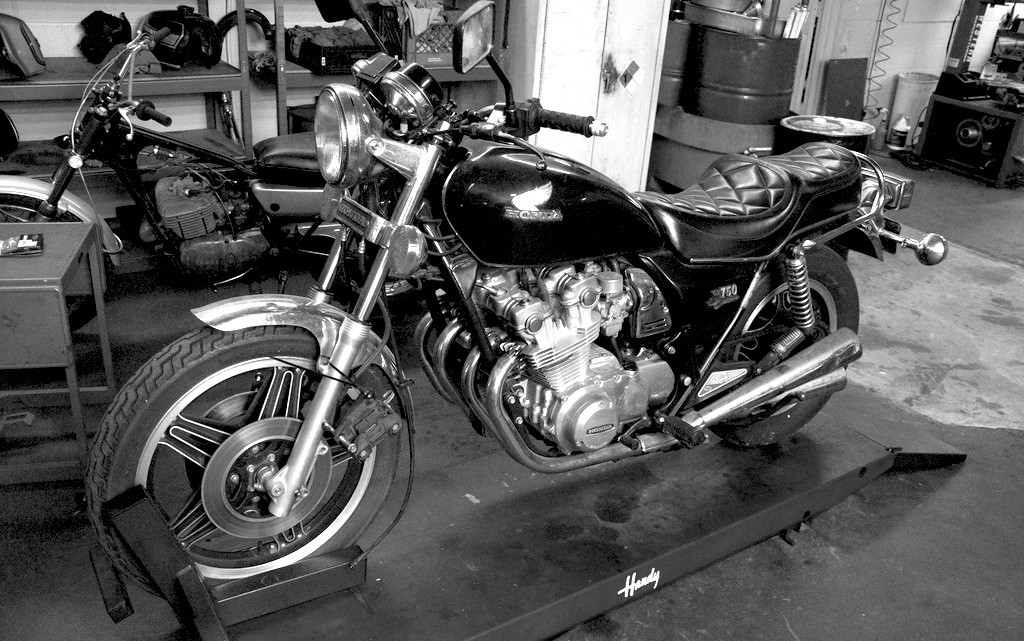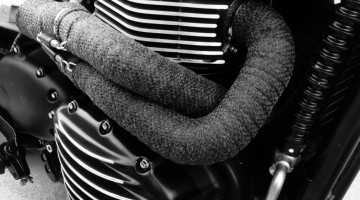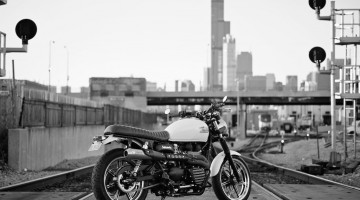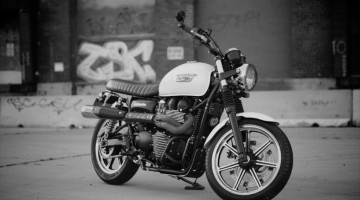On day two of resurrecting my 1981 Honda CB750 Custom, things were going well. The carbs were cleaned out, rebuilt and bench tested. Though I’d already done most of the work myself, by the end of our previous session Jeff, my Moto Dojo sensei, had turned me loose completely on the CB750. We’d gotten to a point where I could cruise on my own for a while — presumably all the way to a running bike — so Jeff told me to just drop by whenever and keep rollin’. So the following Friday afternoon I headed back to BlueCat Motors hoping to get the CB750 up and running again. Rumpal was out of town on vacation, so that meant there was even an empty lift I could use. I love it when I get to wrench on things during business hours. It’s like I’m a kid pretending to be a real mechanic.
I rolled the CB750 up onto the lift on what was a simply lovely September afternoon, a gaping hole in its guts where the carbs ought to be. I grabbed the carb rack off the shelf and started lining up the boots. Getting the rack back on the bike was a bit easier than pulling it out. With each boot cleaned and oiled, it wasn’t long before I was tightening up ring clamps all over the place. Next, of course, came my [not] favorite part of carb installation: the throttle and choke cables. Sometimes it’s easier to install these before you get the carbs clamped back in place. On the CB750, I kind of split the difference. I got the cable ends in place, clamped up the carbs, then got the adjusters placed and tightened up. Again, easier going on than coming off, but still a pain in the knuckles.
Next came replacing the old, cracked fuel lines and a new fuel filter running from the tank to the vacuum-operated fuel cutoff valve attached to the carb rack. Besides access to tools and equipment, being able to work down at BlueCat Motors has other conveniences. They’ve got stocks of fresh fuel line, filters, spark plugs and other little odds and ends that saves me the inevitable 20 trips to O’Reily’s and back. What I they don’t have, unfortunately, is unlimited time. Keeping this in mind, I wanted to get up and going and get out of their way — especially since this wasn’t an after-hours session. There was a lot left to do, and not a lot of day left to do it in.
So I got truckin’. With the carb rack back on the bike and the fuel lines replaced, it was time to see if I’d managed to breathe life into the old beast. While the carbs were soaking in our last session, I’d changed the oil and installed a new filter, so that was good to go. The air filter wasn’t too clean, but wasn’t too dirty either, so I left that for winter. I figured there was nothing holding me back at this point from trying to start the engine. I was nervous though. This was the first time I’d done something like this more or less on my own. I asked Jeff and Robb for a final checklist of things prior to launch. Fuel. Air. Spark. Lubrication. Check, check, check and check. I was good to go. I grabbed the BCM jump box to stand in for the atrophied battery. Unfortunately, the jump box didn’t have a whole lot of jump left in it. I hooked up the baby bottle and opened its flow valve. The jump box did its best, but I only got a few good turns of the engine before it conked out on me completely. No joy. The engine fired and ran for just a second, but without being in sync, and without a dialed-in idle mixture, there was no way it was going to run right on its first try. I plugged the jump box back into its wall socket and switched to other tasks. The engine would have to wait.
I used this break in the action to see to one of the bike’s missing pieces. It needed a new battery. Pulling a new juicer out of its box, it was time for me to tackle a first for me: filling a new battery with acid. Using the small plastic container that came with the battery, I carefully filled each of its cells with clear acid. It wouldn’t be any good to me right then though, it’d have to spend the night on the charger. That was one more task done though — something else to check of my long but shrinking list of repair tasks I’ve never done before.
This resurrection project had another great first for me. The bike’s twin front disk brakes weren’t releasing. In fact I had to pull the calipers off all together just so we could roll the bike around the shop. Time for a caliper rebuild. I had parts and I had opportunity while the jump box recharged on the wall. It’s surprising, but hydraulic brakes are amazingly simple. The small piston in the master cylinder attempts to compress a viscous, corrosive fluid, which pushes against a larger piston or set of pistons in the brake calipers. The hydraulic force-multiplication of surface area, plus the leverage of the brake lever, multiplies the force of your grip by thousands. It’s pretty incredible, really. With two fingers I can stop about 900 lbs of bike and rider with a physical effort that wouldn’t crush a piece of fruit. Yet these systems are very mechanically simple. It’s just pistons, hoses and o-rings. I understood the mechanics, but I’d never actually had a brake caliper all the way apart before. I was ready though. Thanks to YouTube, I had a good idea what I was doing before I started.
What I didn’t have was a whole lot of was time. I’d swung by BCM during business hours because I had some time off that afternoon. But it was quickly approaching closing time. I hadn’t arranged to be there late, so I didn’t want to get too deep into anything, but I took a stab at the calipers anyway. It took me a second and a couple bits of back tracking to get all the key parts of the first caliper loose, but progress came quickly. I learned right away that you’ve got to loosen all the critical bolts while it’s still attached to the fork, or else you’ve got nothing to brace against. You can’t just hold it in your hand and break loose a bolt that gets hot and cold over and over again each time the bike is used. It’s yet another subtle facet of the art of motorcycle maintenance.
Once I got the caliper frames disassembled, it was time for the fun part. I removed the bleeder nipple and inserted the rubber nose of the compressed air blower. One puff of thick air and the caliper piston shot out with a satisfying FOOP! Sure enough, it looked pretty nasty in there. Hard, crusty bits of old rubber and cruddy brake fluid coated the inner caliper like coral growing on a chunk of shipwreck. The main piston seal looked good though. That boded well, as I only had one set of new rubber and I had two calipers I’d like to get rebuilt if I had any hope of having something to ride this season. I’d waited on parts long enough this year. I’d have to watch for leaks, but as they weren’t leaking before, I figured I’d probably be fine. Using an angled pic, some 3M scrub pad and a lot of elbow grease, I got all the crud worked out of the caliper cylinder and polished the piston. Aside from just being dirty from years of inky old fluid passing through it, it looked like it was in perfectly good shape. In fact, neither caliper seemed particularly seized up once they were apart. There was no major scoring on the pistons and the seals were all in reusable shape, but I used what new rubber I had. It wasn’t obvious at the time, but it turned out that my front brake problems had nothing to do with the calipers. Even still, it was worth doing as now I know their true condition.
As I bolted the calipers back into place, I was running out of time. BlueCat Motors was closing up shop for the night. All the bikes had come in from outside and the garage door had been pulled down. Shop hours were over. Everybody had pulled up a chair for an end-of-day beer or smoke. I was the only one still working. This was fine with me, but I figured I’d better wrap up. I pulled the top off the front brake master cylinder’s reservoir tank. It was caked with about a 2 mm layer of sticky, orange crud from the old brake fluid. (New fluid is basically clear.) Ryan and I started to clean it out and flush the brake lines with fresh fluid. We started, but we didn’t finish. The power bleeder used up the last of the compressor’s stored air, and the system had been shut off for the night. That was it. My garage session was over. The brakes would have to wait. By the time I packed up my tools, it was just me and Ryan in the empty shop.
I tried for one last hurrah, though. Grabbing the jump box, Ryan and I attempted one last start of the motor. It hadn’t charged for long, but it was enough to give me a good couple starting attempts before it gave up again. This time, the engine fired and sputtered initially, then just turned over limply — like shaking an unconscious person, trying to wake them up. Thwarted again. Oh well, I’d have to come back for the brakes anyway. It wasn’t until I started putting away the shop’s tools that I realized I hadn’t hooked up the baby bottle during that last starting attempt. Pro tip: engines don’t run without fuel. [Facepalm]
With that session wrapped and the bike still incomplete, I went home. That evening though, the bike was bugging me from afar. I’d made a lot of progress, but I still wasn’t done. That was frustrating. I also felt like I’d been in the way that night. I hadn’t actually held anybody up at the shop, but I felt like I’d been a bit of a bumblebee in a jar. The last thing I want to do is outstay my welcome. When I get focused on fixing a bike, I can get pretty bad tunnel vision. Mostly, this dedication is a good thing, but it can get a bit manic. I had this nagging sense like I’d left a bunch of tools out in the shop. I was sure I’d left the power bleeder on the lift, rather than up under Jeff’s bench where it belonged. Here they’d been so generous with their time and their facilities and I was just sure I’d left something sloppy in my wake. I was convinced that they’d be irritated at my imagined mess in the morning. The CB750 was still on the lift, too. For some reason, I felt like I was very much in the way, even though the shop was closed and there wasn’t anything I could do about it. None of this was rational, but I decided I’d better swing by the shop first thing in the morning and not only make sure I’d put everything away, but to get my stupid bike out of their way too.
Saturday morning came and it was gorgeous. I hopped in the MINI and headed down to BCM hoping to catch the guys right as the doors opened. I even intercepted Jeff and his gold 1972 Honda CB250 on his way into the shop. Hauling in my tool box, I was all business. It turned out my angst, as usual, was misplaced. The bleeder was exactly where it belonged. Rumpal was out for the day again, so I wasn’t even remotely in anyone’s way. Nor had any of the guys given me any indication that I wasn’t welcome. I just get this way sometimes — get this overwhelming feeling that people who demonstrate their affinity for me over and over again secretly don’t want me around but just aren’t saying it. It’s a paranoia I don’t understand, and it rears its ugly head now and then. After five minutes back in the shop, that feeling lessened, but I still wanted to get my mess of a bike out of the way. I didn’t have time to continue working on it that day anyway as The Mrs and I had other plans. So all I did was retrieve the new battery from the charger where it’d been juicing all night and slide it into the CB750’s battery compartment. Though it’d been on the charger all night, it hadn’t switched over to trickle. This seemed odd, but I figured it’d either work or it wouldn’t. Little did I know, this oversight on my part would come back to nibble on my butt down the road. I hung the baby bottle and plugged it into the vacuum cut-off valve for a quick try of the engine. Sure enough the new battery turned the starter enthusiastically. Still no growl though. After a few minutes of fighting the choke and the throttle to no avail, I finally threw in the red shop rag.
I’d hit my limit. I’d tried. I’d failed. It wasn’t running, and I didn’t have any idea why. Once again, the machine was beyond my power to heal. I needed someone else’s stronger magic. Furthermore, I’d need it quick if I was going to have a running bike of my own this season. I knew Jeff, Ryan and the boys would take care of me, but the season was running out. The GL1100 was still waiting on brake parts, and the CB450 was on the engine transplant list. Winter was coming and the last thing I wanted was three dead bikes at BlueCat Motors all winter taking up valuable space they could sell for winter storage.
My hope for the CB750 had been to sort that bike out that weekend. As usual, my ambition had outpaced both my abilities, and the bike’s willingness to cooperate with my schedule. While this was discouraging, it was also a much needed reality check. I couldn’t do all of this myself. As fun as it is to work on old bikes, I couldn’t keep drinking from the fire hose like this. I simply didn’t have time. Not only was I taking up my time, but I was taking up BCM’s time by doing the work myself. Bottom line, my goals weren’t inline with my methods. It was time to change tactics. It was time to ask for help.
To be continued…
![]()




